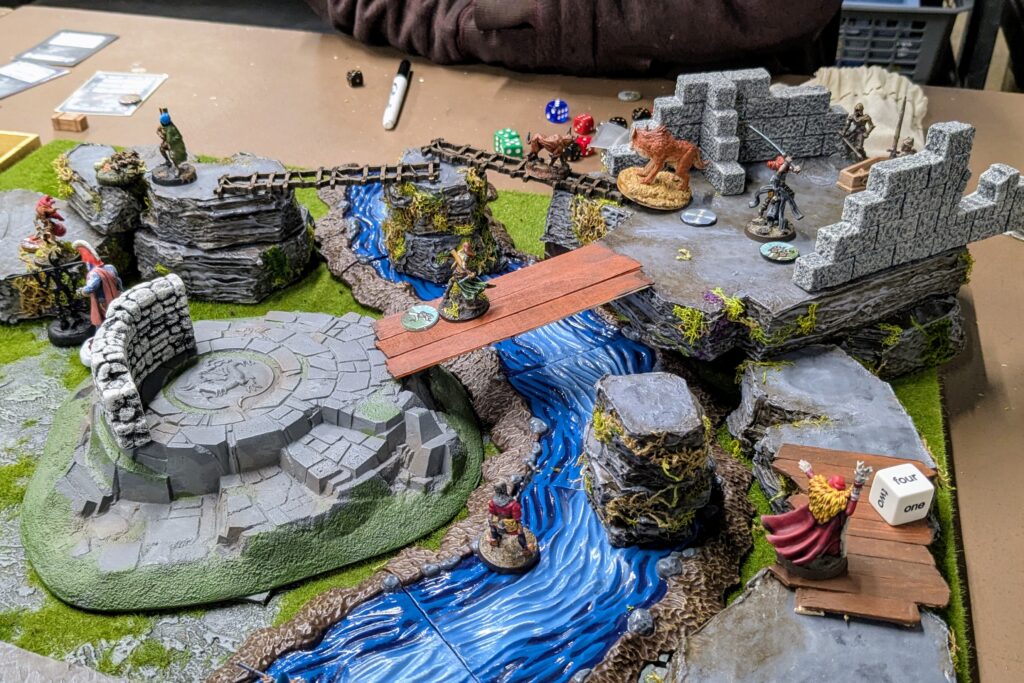Almost every character had an important role—even if that was just hiding in a nook holding treasures delivered by teammates. Pretty funny watching big ol’ boys like Ihm’ Matt and the Swarmlord come marching over bringing goodies to hunched little Vermin Mouth lurking in some ruins. A tremendous amount of maneuver in the game as well, one of the things I appreciate most about Relicblade, with action everywhere and characters enacting really dynamic paths with lots of advancing, retreating, and even resurging. Great imagery as Nelda the Keeper went running across a series of ladder bridges behind her Sabertooth companion, transforming into a Cave Bear mid-air as they leapt at a skeleton together. Teklin, grenadier extraordinaire, held all foes out of his corner, charging onto a bridge, leaping into the river, and struggling mightily against the current to reach a raised dais perfect for sniping, all while putting out extraordinary damage at range. As usual a clear standout was the humble Billman, salt o’ the urth, dashing across rocks, rivers, and bridges, clobbering vagrants, and holding off frickin’ yetis and their silly long arms to singlehandedly claim multiple treasures. Fittingly, in the end the closely fought battle wound up a draw at the last possible moment when Lotus Bladesong tried for the relic in the final activation of the game but got tripped up just enough by Nelda’s Sabertooth that the Bladesong then wasn’t ready when the last two skeletons lurched up out of the dark and skewered her, dropping both the relic and the small treasure she’d picked up early on… Honestly didn’t even occur to me to just sit pat and take the minor victory rather than making a play for the relic and risking a draw.
BMS School Rocket
Cloud Cuckoo Land
 Cloud Cuckoo Land. Doerr. An imaginative story of five people spanning from the fall of Constantinople in the 1400s to the Korean War in the 1950s to present day Idaho to a generation starship in the 22nd century, all connected by a fictional lost Greek fantasy epic from the 2nd century. The novel opens with gusto as the short chapters bounce between these very different settings and it’s not clear at all how some of them will come together. Somewhere in the late middle that mystery is lost, even before being actually resolved, but the novel has shifted to an appealingly sweet paean to books and storytelling. Normally I’m viscerally opposed to self-congratulating media but it’s well done here, possibly because the stakes remain largely individual. Doerr stretches his oeuvre a bit in this work to science fiction and it shows: All the historical sections are very good but the lite sci-fi near future and far future segments are comparatively tepid and implausible, although they don’t bring the book down. The other storylines are infused with such good characters and the soft joy of story that it’s a great book.
Cloud Cuckoo Land. Doerr. An imaginative story of five people spanning from the fall of Constantinople in the 1400s to the Korean War in the 1950s to present day Idaho to a generation starship in the 22nd century, all connected by a fictional lost Greek fantasy epic from the 2nd century. The novel opens with gusto as the short chapters bounce between these very different settings and it’s not clear at all how some of them will come together. Somewhere in the late middle that mystery is lost, even before being actually resolved, but the novel has shifted to an appealingly sweet paean to books and storytelling. Normally I’m viscerally opposed to self-congratulating media but it’s well done here, possibly because the stakes remain largely individual. Doerr stretches his oeuvre a bit in this work to science fiction and it shows: All the historical sections are very good but the lite sci-fi near future and far future segments are comparatively tepid and implausible, although they don’t bring the book down. The other storylines are infused with such good characters and the soft joy of story that it’s a great book.











